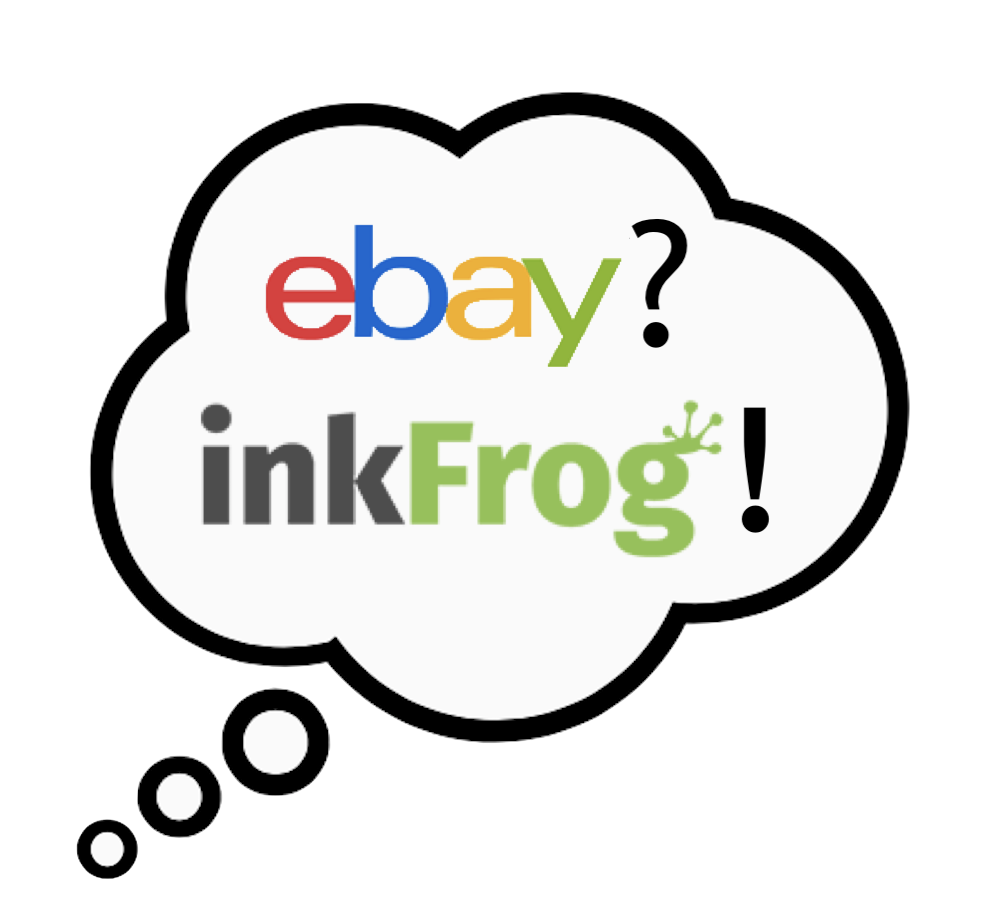/lib/images/FBAvsEMD.jpg
When it comes to scaling your business, you’ve got to learn to delegate. Every entrepreneur knows the headaches that come from wearing too many hats; as the old saying goes, “If you want to grow, you’ve got to let go.”

You can delegate in two directions: by hiring in-house help, or by outsourcing. The most successful businesses do both. And in the case of ecommerce businesses, the first thing that gets delegated is usually shipping. Amazon sellers — and a surprising number of cross-platform eBay sellers — have long enjoyed the benefits of Fulfillment by Amazon (FBA).
A Fulfilling ExperienceWith FBA, sellers ship products directly to Amazon to be stored in the company’s nationwide network of warehouses. Amazon then takes charge of picking, packing, and shipping sold items; they also provide customer service, i.e., sending tracking info and handling post-sale inquiries, returns and refunds. That’s a big load off your shoulders!
Not to be outdone, eBay is launching what some sellers are calling “Fulfillment by eBay”. Its real name is Managed Delivery. Like FBA, Managed Delivery will fulfill orders placed via other online marketplaces as well as on their own platform.
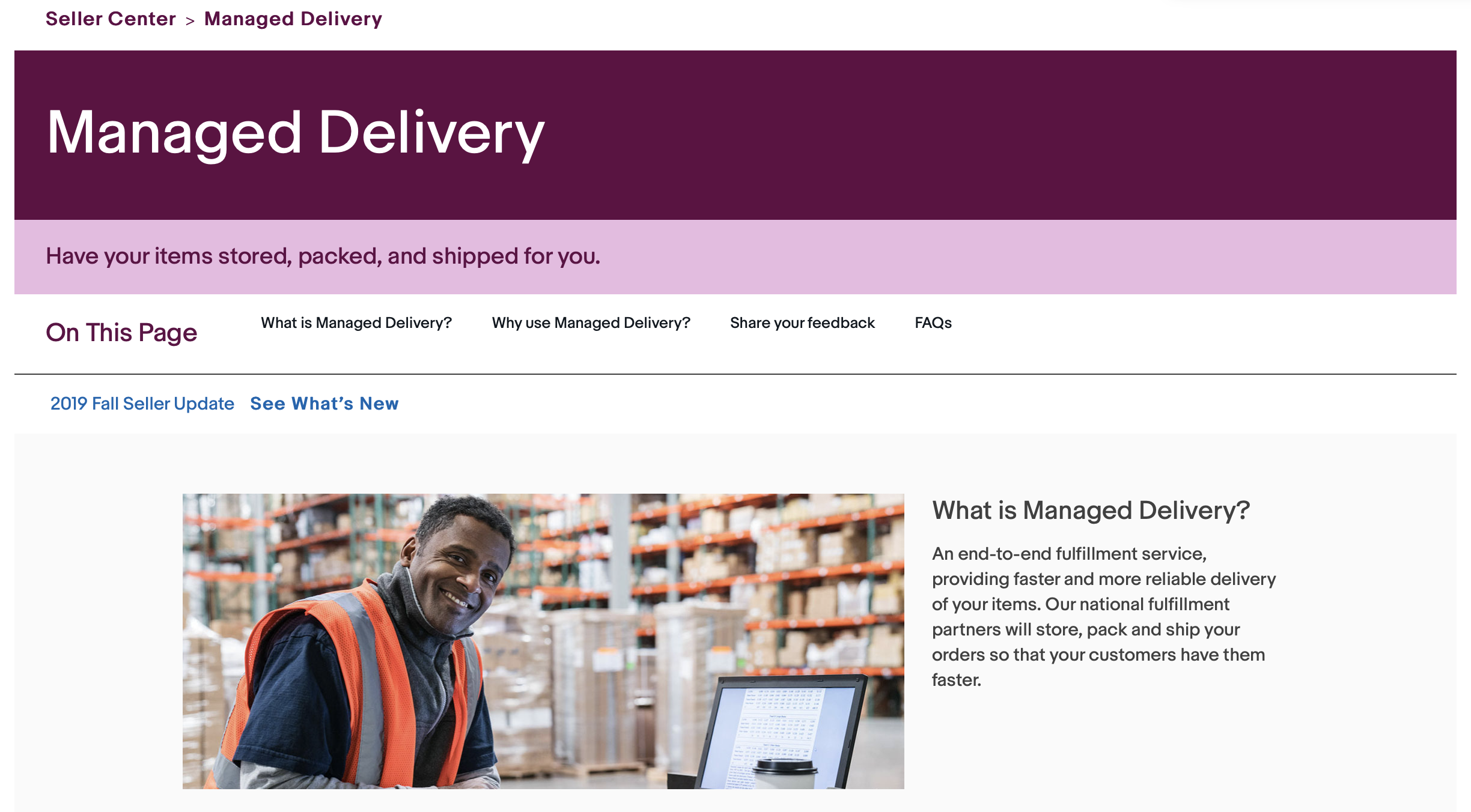
However, true to eBay’s tradition of being “just a venue”, the company is outsourcing this end-to-end fulfillment service, partnering with trusted logistics partners to warehouse, pack, and ship sellers’ items while eBay handles customer service.
Managed Delivery was introduced earlier this year as a pilot program. It’s not for everyone. According to the eBay Inc. blog, “The initiative will enable sellers with high-volume inventory to meet rising consumer expectations while reducing cost and complexity.”
In other words, if you sell a lot of widgets, you can stash those widgets in various strategic locations across the country, reducing shipping costs, delivery times, and the number of headaches in store for you.
What’s in It for Whom?How does Managed Delivery stack up against FBA? That remains to be seen, because eBay’s new program is slated to roll out in 2020. Here are some points to consider.
FBA items are eligible for Amazon Prime two-day shipping as well as free shipping. There’s no minimum; send the company as few or as many products as you like. Amazon charges for storage space and for each order fulfilled, including the cost of shipping.

Depending upon the time of year, a cubic foot of storage space may cost as little as 69¢ (January-September) or as much as $2.40 (October-December). Order fees start at $2.41 for an item weighing less than 10 ounces. For example, a T-shirt in size Large will have a shipping weight of 11 ounces and incur a per-unit storage fee of 40¢ plus a fulfillment charge of $3.68.
By contrast, at this point eBay is serving up a fair amount of pie in the sky. Managed Delivery is “the third pillar of eBay’s ongoing evolution” into “a more managed marketplace”, with the first two being the eBay catalog and Managed Payments. The company promises benefits for both sellers and buyers:
Benefits for Sellers
- Lower fulfillment costs
- Enhanced seller protections
- Faster, simpler shipping
- Increased visibility in search
- Savings on storage space and expense
Benefits for Buyers- Speedy delivery
- Quality branded packaging
- Reliability (100% tracking
- Prompter customer support
For eBay, the benefits lie in being able to offer a more uniform delivery model and thus a better (or at least more predictable) shopping experience. In addition, with 1.5 million items shipped by eBay sellers every day, the proliferation of eBay-branded packages on front porches nationwide will “enhance eBay’s brand identity as a popular consumer shopping destination”, according to the corporate blog.
For high-volume sellers of commodity items on eBay, Managed Delivery is designed to be a win-win-win, just like Fulfillment by Amazon. eBay is currently working with several logistics partners and will determine which partnership(s) to retain as they scale Managed Delivery site wide.
No word on pricing yet other than that it will be “industry competitive” and “announced closer to launch”.
The Bottom Line
Amazon has always been a managed marketplace where sellers are expected to toe certain lines, whereas managing eBay sellers is more like herding cats. Small wonder that eBay Inc. has embraced Managed Delivery as a way to homogenize the platform’s buying experience! Meanwhile, small sellers will continue to deliver the quirky goods that make eBay unique and wonderful.
If you’re looking to grow your ecommerce business, delegating fulfillment duties to Amazon’s
FBA and/or eBay’s new
Managed Delivery can literally pay off, big time.
Posted on January 10, 2020
So you want to start selling on eBay. Or you’re already selling on eBay, but you want to be more successful. Or maybe you’re selling on another ecommerce platform (or platforms) or have your own website. Wherever you are in your ecommerce journey, inkFrog can help you with selling on eBay and more.
Read full article now
Posted on October 16, 2019
When it comes to scaling your business, you’ve got to learn to delegate…and in the case of ecommerce businesses, the first thing that gets delegated is usually shipping.
Read full article now
/lib/images/ebay_to_ifo_to_amazon2.png
So you’ve decided to take the plunge…make the leap…put your eggs in more than one basket…add another selling channel. However you phrase it, the bottom line is that you’re ready to expand from eBay onto Amazon.
That’s exciting! But the thought of getting all your items listed on another platform? Not so exciting. In fact, it’s downright daunting.

That’s where inkFrog comes to your rescue. The same tool that helped you create great-looking templates for your eBay listings can now help you create great-looking Amazon listings for those same products.
Thanks to inkFrog, you don’t need to know much about Amazon listing design. There’s an app for that: inkFrog’s new Channel Connector, now available in Beta. It can take your entire inkFrog library of listings and upload the contents to your Amazon store with just a few clicks.
What you do need to know, however, are the differences between an eBay listing versus an Amazon listing.
eBay vs. Amazon
Just as on eBay, every Amazon listing starts with a title; eBay gives you 80 characters, whereas Amazon gives you 200. Use them wisely and well!
Next, on eBay, you fill out item specifics, preferably including a product identifier such as a UPC, EAN, GTIN, MPN, or ISBN. If an item has none of those, you can select “Does not apply".
But on Amazon, every product must have a unique identifier. Those lacking one of the above are assigned an Amazon Standard Identification Number, or ASIN: a 10-character alphanumeric identifier that’s unique to the Amazon marketplace. Your product may already have an ASIN, but if not, inkFrog can generate one.
Pictures Worth a Thousand Words
Photos are crucial to both eBay and Amazon templates. eBay recommends square photos on plain white backgrounds; Amazon requires product images to be at least 1000dpi on a white background. Pictures should show only what’s in the listing, with the product filling at least 80% of the image area and no text or watermarks.
If your eBay photos don’t meet Amazon product template standards, you’ll find that bringing them up to par will also make your eBay listings more effective. Win-win!
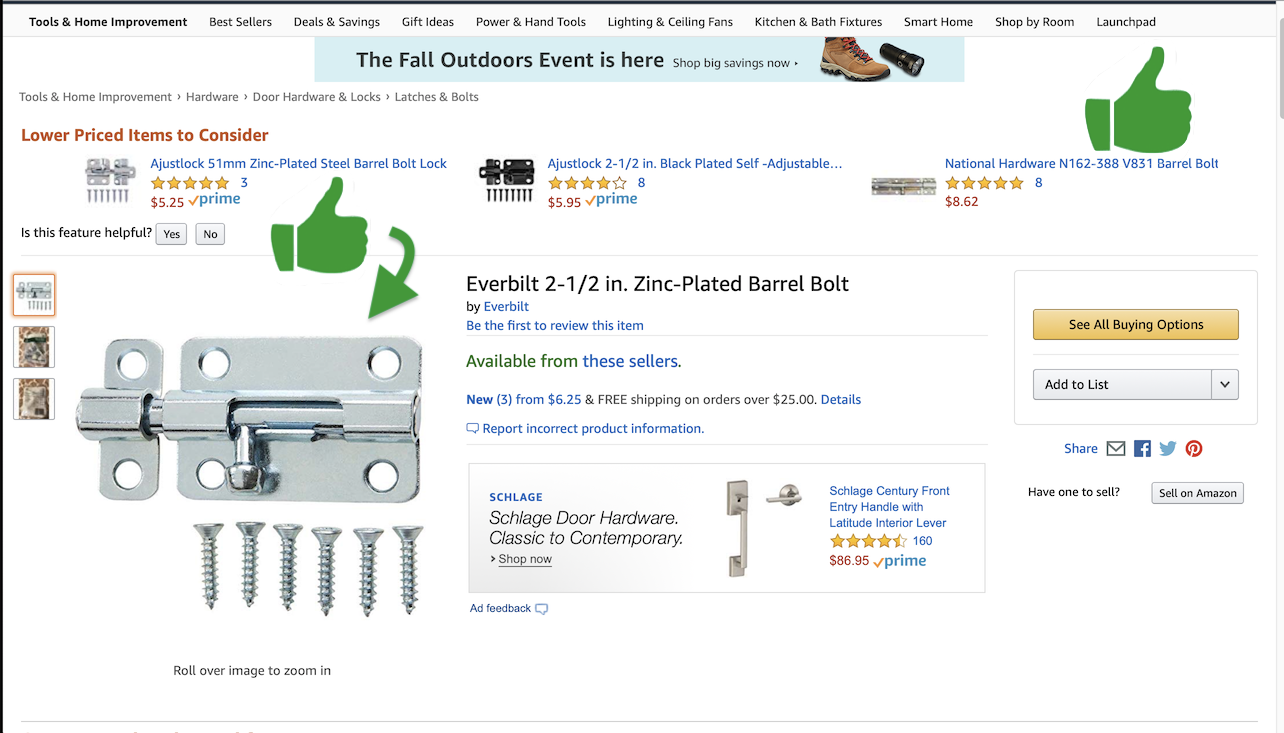
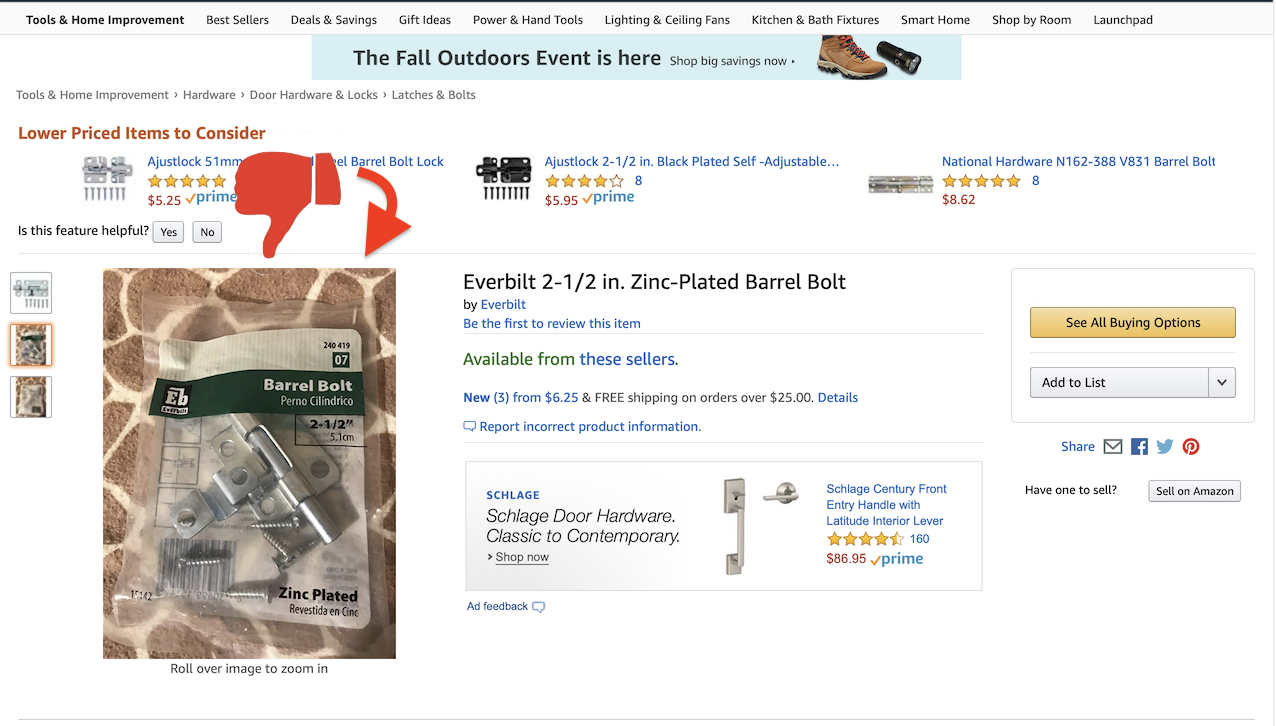
The major difference between eBay and Amazon listings is how descriptions are formatted. On eBay, sellers can pretty much write whatever they want, in as many colors and fonts as their hearts desire. It’s unprofessional and not recommended, of course, but it’s up to you whether or not to follow best practices.
Amazon doesn’t give you that much leeway. Their Quick Start Style Guide spells out the Do’s and Don’ts in black and white. The Don’ts:
- No HTML in descriptions except for the line-break tag
- No details about availability, price, or condition
- No requests for customer reviews (feedback)
- No reviews, quotes, or testimonials
- No contact information, including website URLs
- No links to outside websites
- No information about you, your company, shipping, or promotional offers
The Do’s:
- Highlight your product’s top 5 features via bullet points, such as size; style; model number; color; and what the product does or how it can be used
- Write the rest of your description in complete sentences, with correct spelling and grammar
- Use numbers for all numerals
- Spell out units of measurement, such as inches
Again, editing your descriptions Amazon-style may make your eBay listings better, too.
Using inkFrog’s New Channel Connector
Ready to export your inkFrog library to Amazon? Channel Connector makes it easy. You can export all your listings, or manually select which ones to export.
Furthermore, you can export inkFrog’s product description, or write your own. If there’s a problem translating any of your eBay listings into Amazon product page templates, Channel Connector will tell you what to fix.

Once exported, your products on Amazon are automatically linked to your listings in inkFrog, and they’ll sync according to whatever criteria you select. No need to worry about overselling or fool with spreadsheets.
Now your Amazon store is ready for Prime time! And you’re wondering why you ever thought expanding from the Bay to the River was going to be such an ordeal. Thanks to inkFrog’s new Channel Collector, your big move was no big deal.
Posted on September 18, 2019
Growing Your Business from eBay to Amazon with inkFrog's New Channel Connector
Read full article now
/lib/images/ebay_to_ifo_to_amazon2.png
You’re crushing it on eBay, successfully selling in at least one niche. Your products are hot! And you’d like to get them in front of more potential customers, so you’re ready to expand to another sales channel. Amazon seems like the natural next step.
But how can you easily list your items there? The two sites are very different in terms of listing styles.

The River vs the Bay
Not to worry, it can be done! The first thing you need to do is to familiarize yourself with Amazon’s rules for product detail pages, a.k.a. listings. The River’s policies around formatting listings are detailed and fairly stringent — much more so than is the case on eBay, which is virtually the Wild West compared to Amazon.
The good news is that you may find that following Amazon’s listing guidelines helps you to improve your listings on eBay.
For example, here’s some sound advice from Amazon’s Quick Start Style Guide that applies to eBay as well:
“The way you present your products influences a customer’s decision to buy your product…Provide clear and concise product information in a consistent format to attract customers to your products.”
Listing Amazon Style
Some types of products have special style guidelines, but most are covered by Amazon's helpful Quick Start Style Guide. It spells out exactly how to write and format your title (you’ll have 200 characters on Amazon, including spaces, versus 80 on eBay) and your description. You can’t use HTML, JavaScript, or other types of code in the latter, with the exception of HTML’s line break tag.
Some more Amazon requirements with which eBay sellers will need to familiarize themselves:
- No details about availability, price, or condition
- No requests for customer reviews (feedback)
- No reviews, quotes, or testimonials
Other Amazon guidelines will be second nature to experienced eBay sellers:
- No contact information, including website URLs
- No links to outside websites
- No text or watermarks on photos
Every Picture Tells a Story
Speaking of photos, that’s one area in which you may need to step up your game. Amazon wants product images to be at least 1000dpi on plain white backgrounds. In addition, your pictures should show only what’s included in the listing, with the product occupying at least 80% of the image area. Colored backgrounds or lifestyle pics will garner your listing a quality alert from Amazon. It used to be the case that only the first photo needed to have a white background, but now all of them do.
As for the description, you should:
- Highlight your product’s top 5 features via bullet points, such as size; style; model number; color; and what the product does or for what it can be used
- Include pertinent details such as dimensions, care instructions, and warranty information
- Exclude information about you, your company, shipping, or promotional offers
One more caveat: Unless your product is Private Label, you cannot use your seller name as the brand or manufacturer.
Once you've listed your bullet points, the rest of your description should be written in complete sentences, with correct spelling and grammar. Use numbers for all numerals, and spell out units of measurement, such as inches.
The Good, the Bad, and the Better
Let's look at some examples. Can you see what's wrong with the Product Details page below?
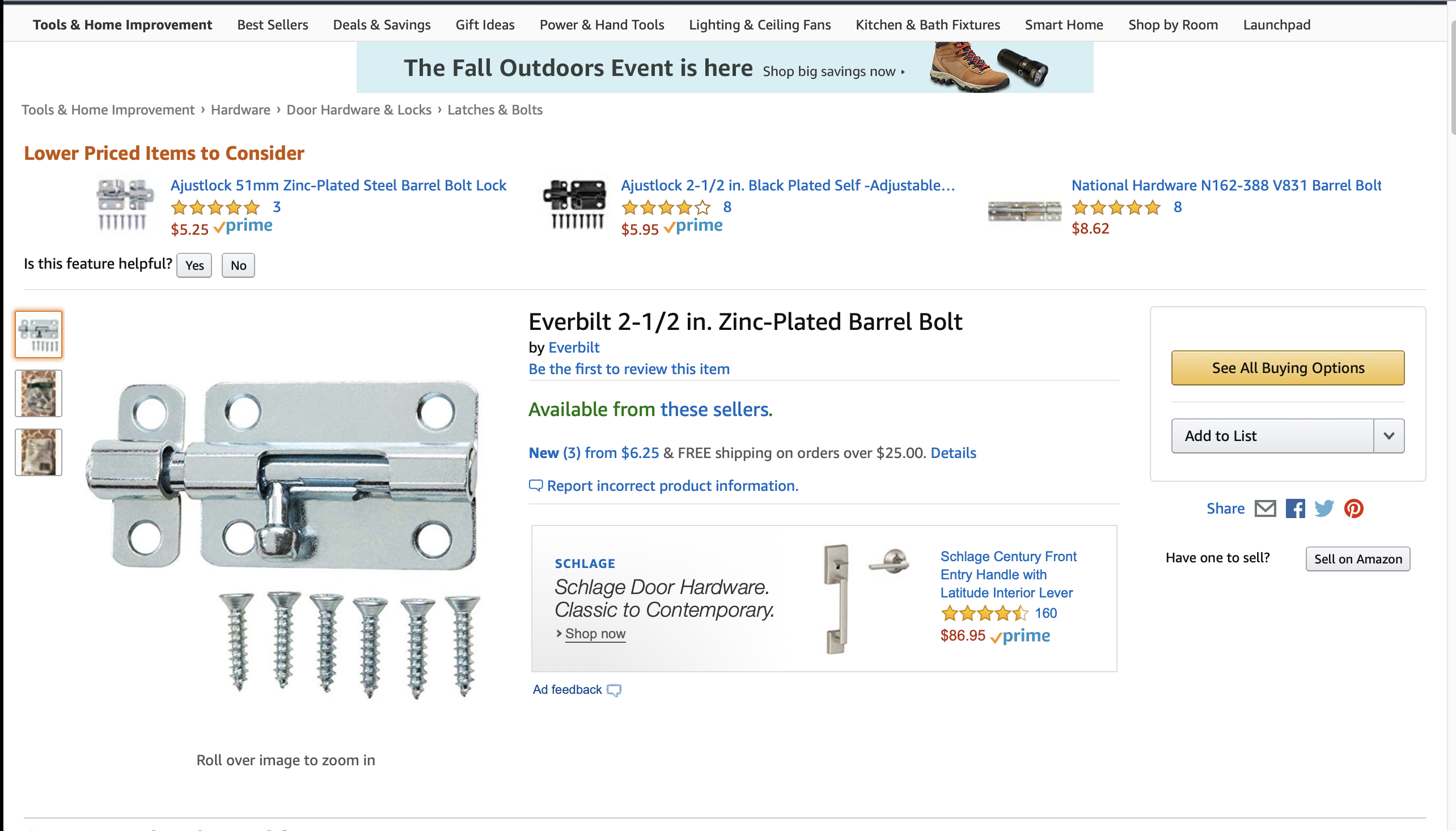
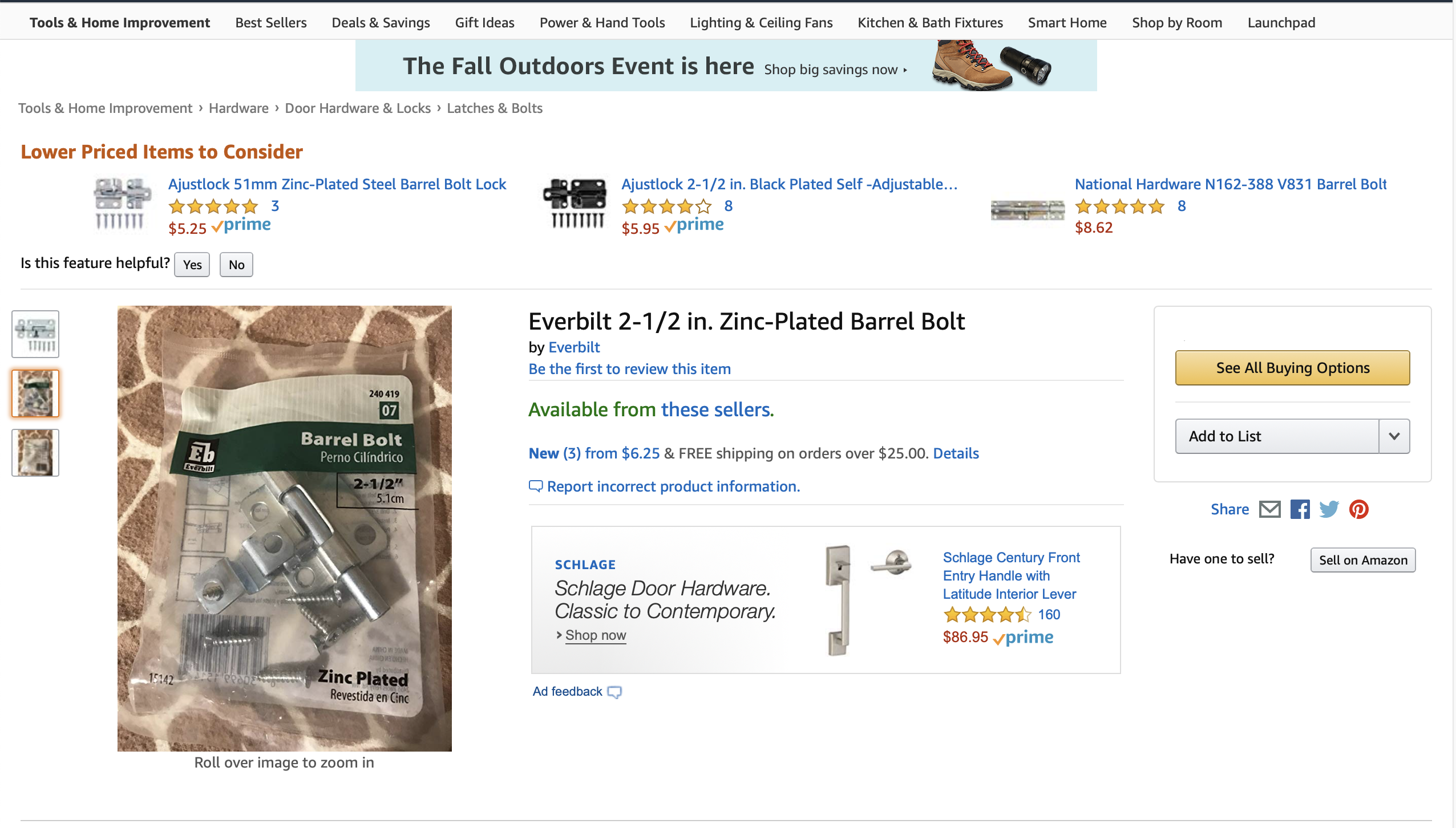
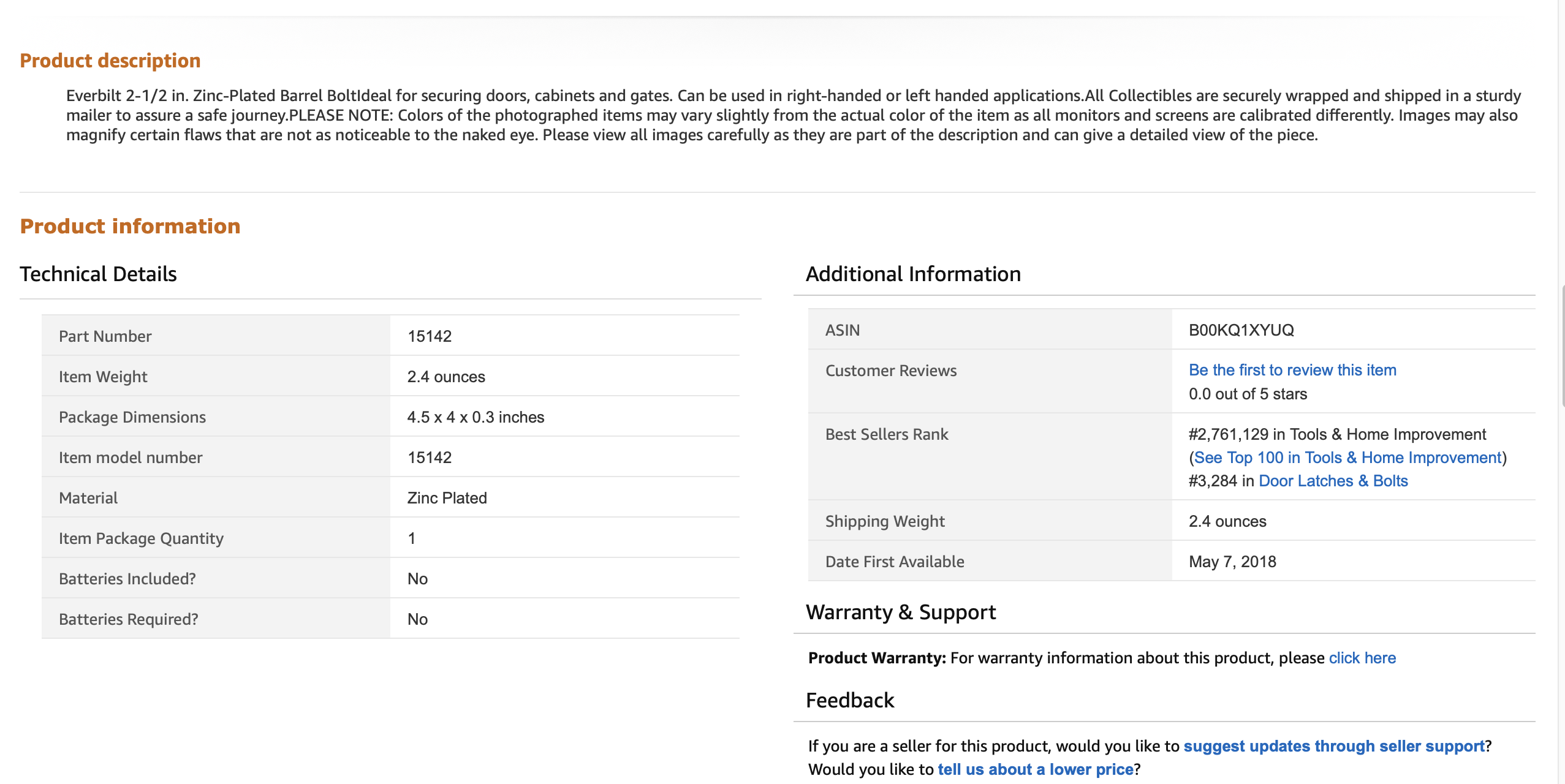
There are 3 problems:
- No bullet points highlighting the product's 5 key features
- 1st photo has an Amazon-approved white background; 2nd and 3rd have colored backgrounds (which used to be allowed, but that changed this year)
- Description has typographical errors and includes company-specific information
Now take a look at this Product Details page for a similar item:
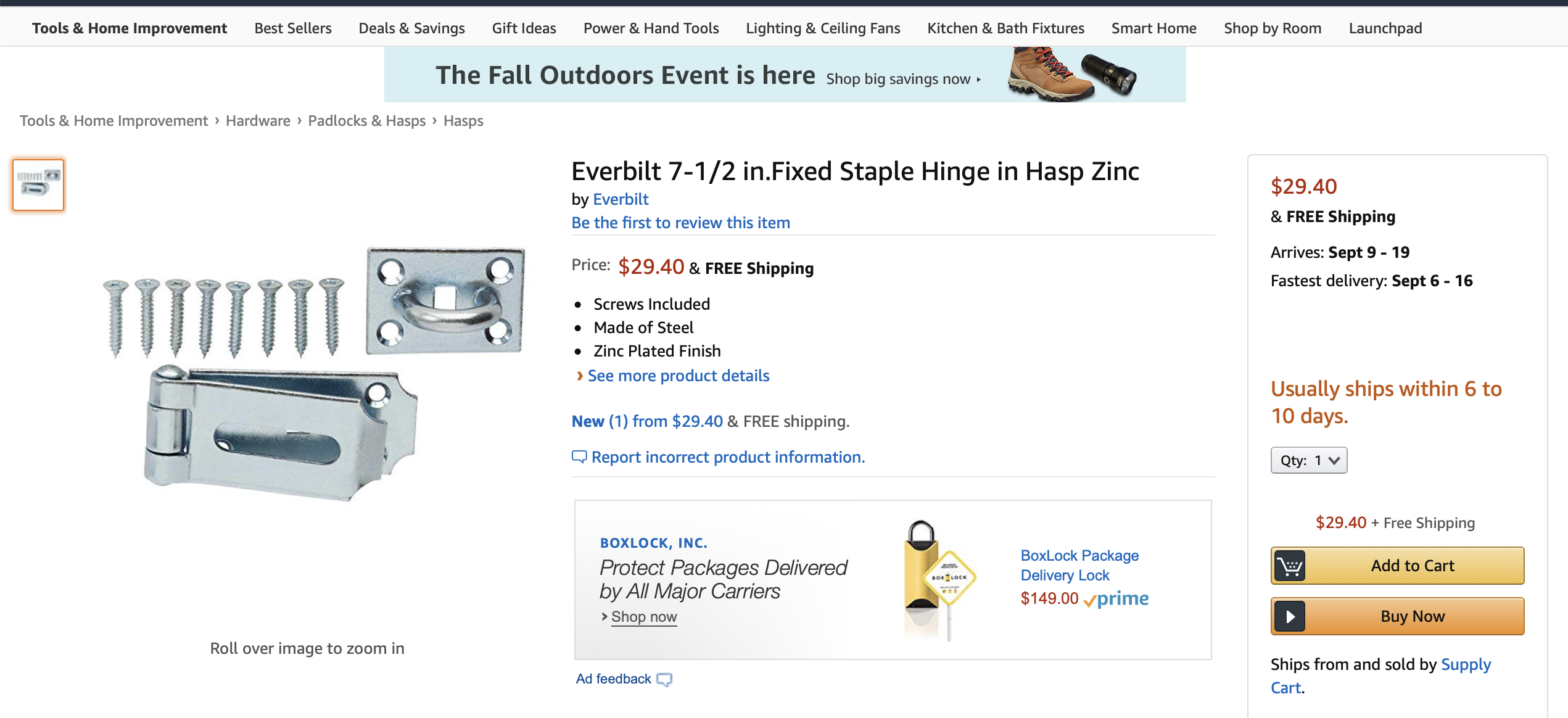
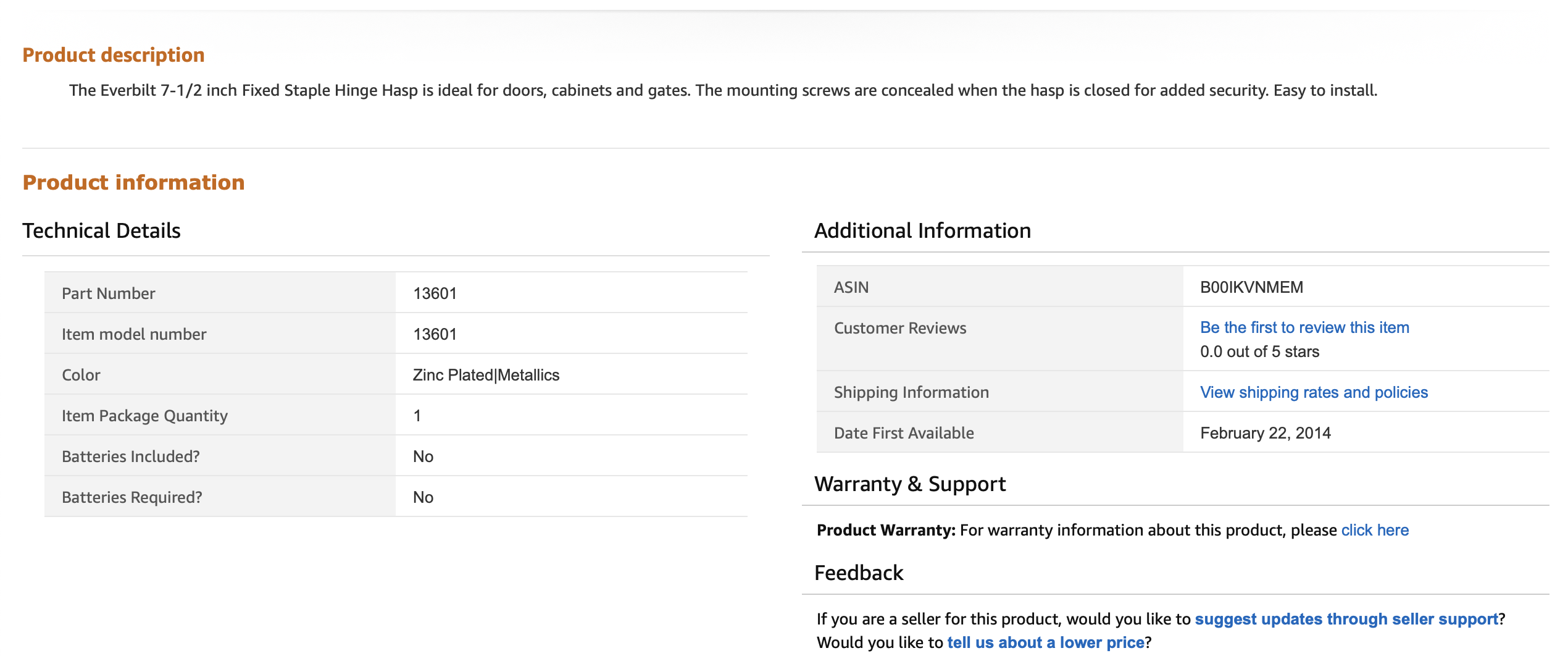
As per Amazon's Style Guide, bullet points at the top of the description highlight the product's most important features; the product image has a white background; and the descriptive verbiage is grammatically correct and to the point.
The listing below is better yet, because it includes more details about the product and how it works as well as more product images (plus it earns bonus points for being funny, although that's easier to do with this product than with the 2 hardware products above). Because this product is in Amazon's Brand Registry, its listing is permitted to include a video along with its images:
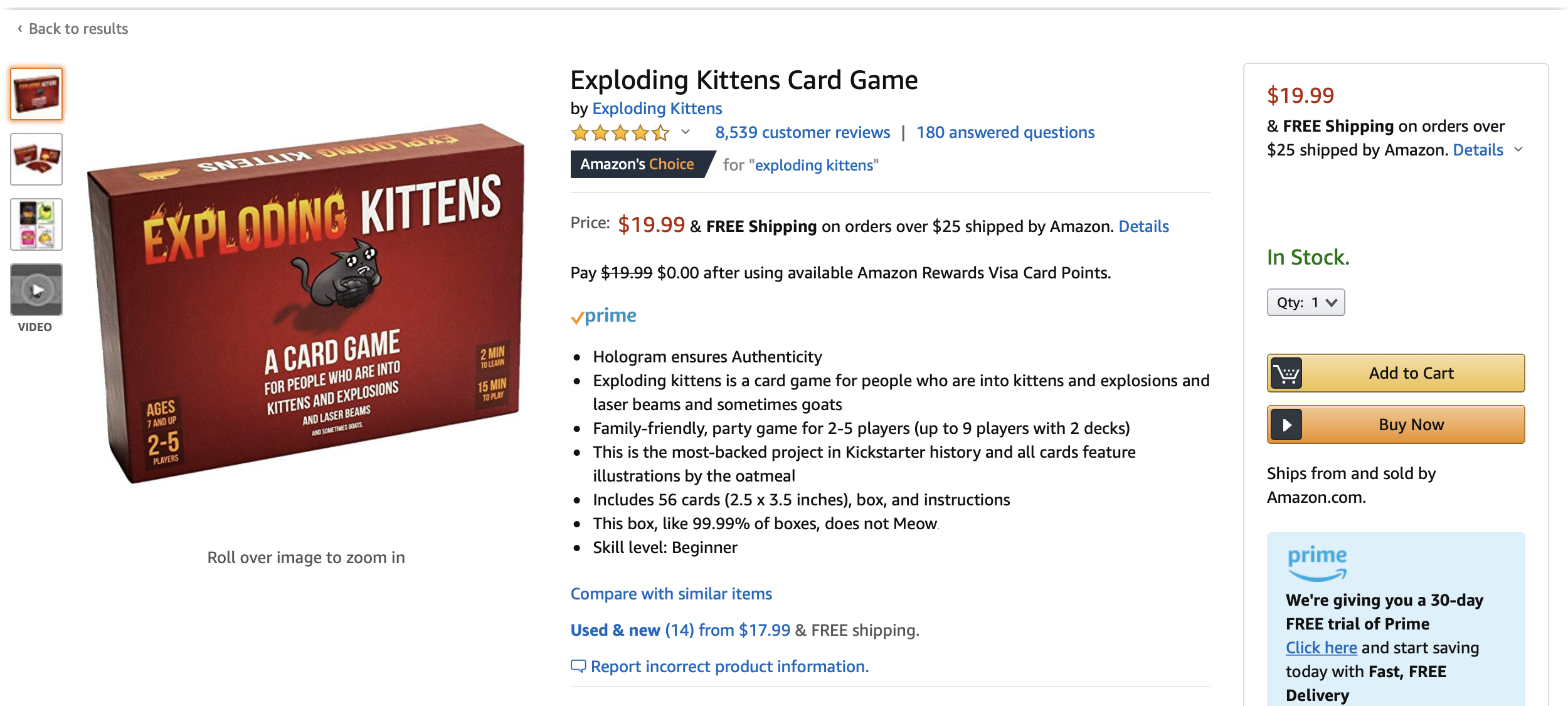
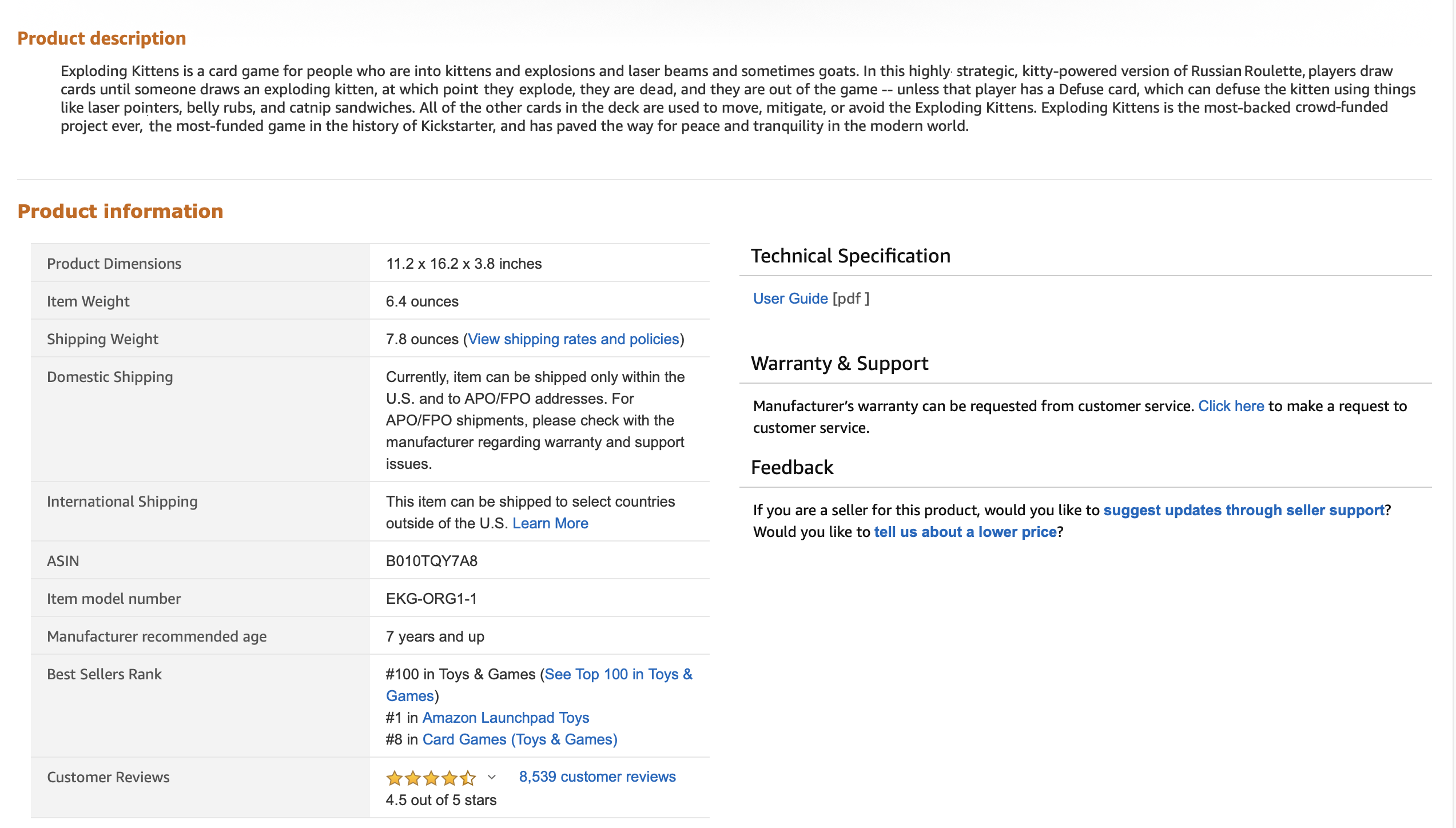
Good News for Good Sellers
If you’re following eBay’s best practices in your listings there, you should have little to no trouble onboarding them to Amazon pretty much as is.
inkFrog makes it super easy to create an Amazon-friendly eBay listing. Just click on "Create new listing" and use the Rich Text Editor to make an unordered list of your bulleted product highlights; then add any further necessary verbiage describing your product and its features. Don't use tables or other special formatting. Keep it simple, clear, and concise.
Next, fill in your item's product identifier (e.g., UPC, MPN, or ISBN), if it has one, and upload your photos.
Once your eBay listing is live on Amazon, inkFrog will automatically sync up your eBay and Amazon listings and sales every 15 minutes, making inventory management easy and preventing you from overselling.
And if you’re branching into multi-channel selling the other way ‘round — expanding your ecommerce business from Amazon onto eBay — inkFrog can import and download your Amazon listings with just a few clicks, then help you create eBay listings for your entire Amazon inventory in seconds. You can even upload those listings across multiple eBay accounts.
It’s a wise seller whose ecommerce business doesn’t depend upon a single sales outlet. If you haven’t gone multi-channel yet, maybe it’s time to consider it.
Posted on August 29, 2019
How to Translate Your eBay Templates into Amazon Listings
Read full article now
/lib/images/ebay-to-shopify-5.png
Our engineering team has been working hard at this brand new feature and we are happy to announce that it is now available to all users. Starting today, you have the ability to take all of your inkFrog library listings and publish them to your Shopify store!
Here's how you do it!
Step One - Link Your Shopify Store
This feature requires a Shopify store to be connected to your inkFrog account. Connecting a Shopify account is
easy, simply click on Apps > Channel connector:
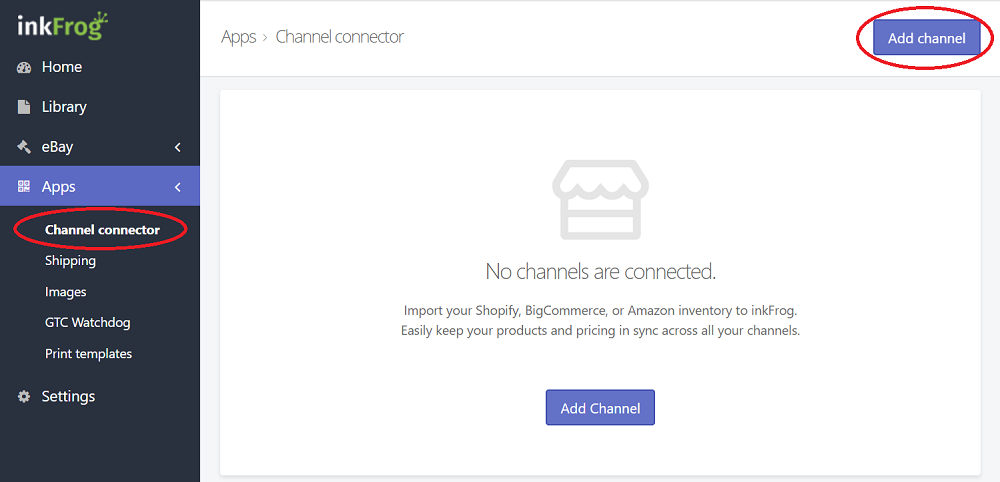
Then click on the Add channel button and go through the connection process:
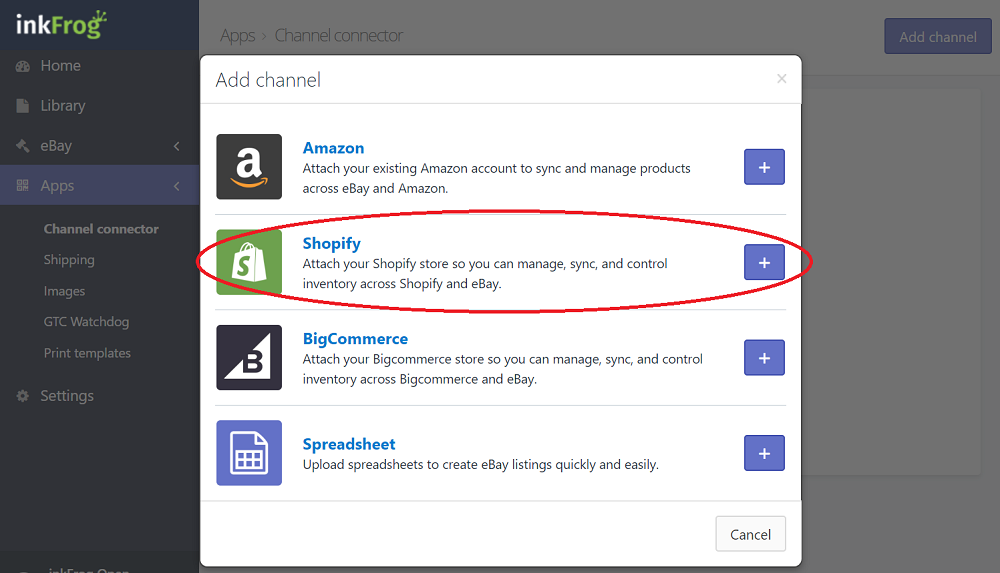
Step Two - Configure Your Sync Settings
This only takes a moment, but you want to verify that the sync settings for the eBay to Shopify export tool are working the way you want. Go back to Apps > Channel connector:

On the channel connector page, click onto Sync & Inventory Control to access your sync settings for the Shopify store connection:
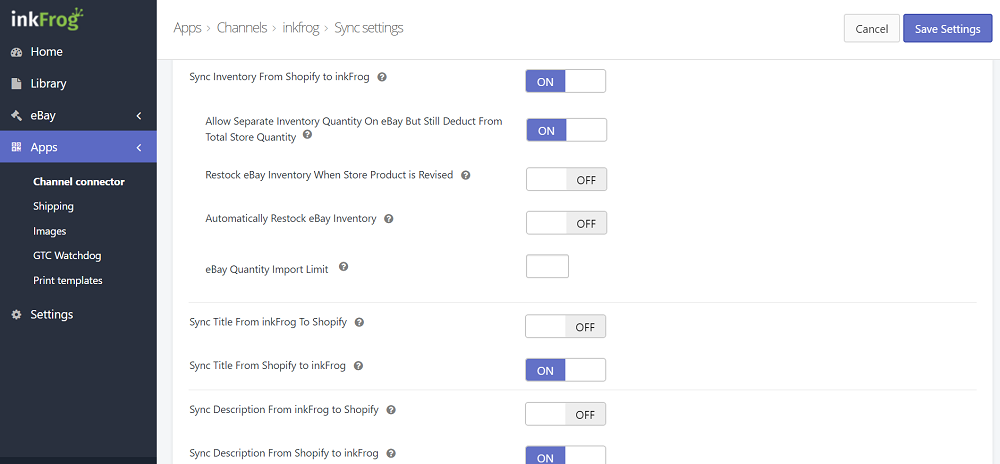
Take a few moments to review how the settings are configured and change them to what suits your business and then click the Save Settings button.
Step Three - Run the eBay to Shopify Exporter
Go back to the Channel connector page like you did in previous steps, however this time you are going to click onto the Export eBay to Shopify button:
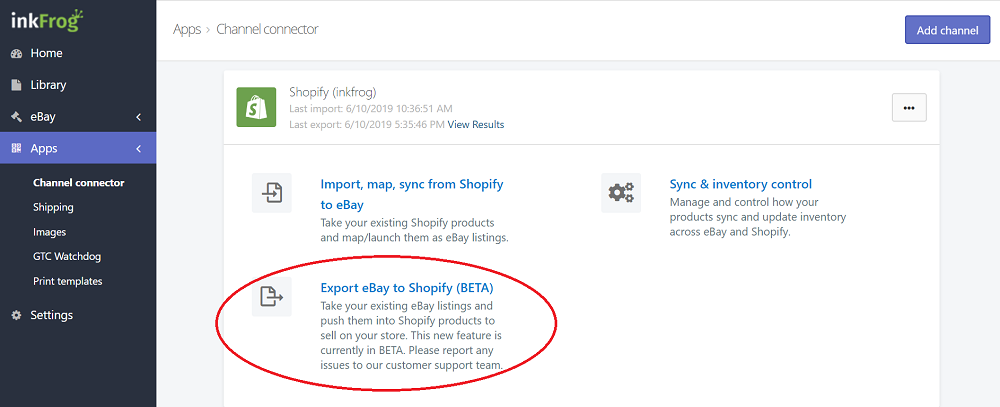
You will then be asked which products you want to export from eBay to Shopify. By default it will want to export all of your listings, however you have the option to specify if you only want certain products to be exported to Shopify:

Let's say, for example, that we only wanted to export a cat scratch stand that we are selling. We select that specific product instead of all of them and then click on the Next button:
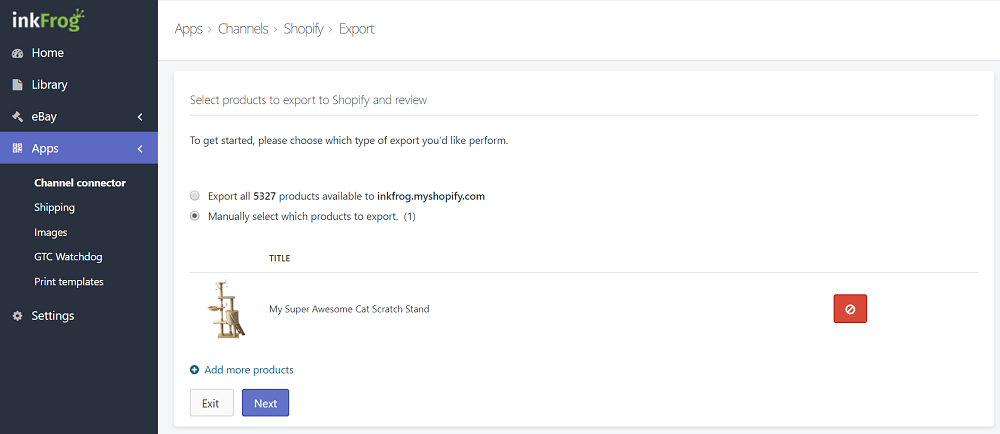
inkFrog will scan the eBay listing(s) you selected to make sure there are no problems with them before exporting them to your Shopify store. If there is a problem it will advise you of what needs to be done, otherwise you should see a screen like this which means everything is good and ready to go, simply click the Export button in the top-right corner:

When you click that export button, we will send your eBay listing to Shopify. You will see a loading screen like this, simply wait for it to complete:

When it has finished the transfer, you will get a confirmation page showing all of the products you exported and confirming it worked:

Your product(s) are now listed in Shopify, if you go to your Products page in Shopify you will see it:

You aren't quite done yet. By default, Shopify sets them to not appear in your Online Store. You need to edit the product in Shopify and check the Online Store box in the item details:
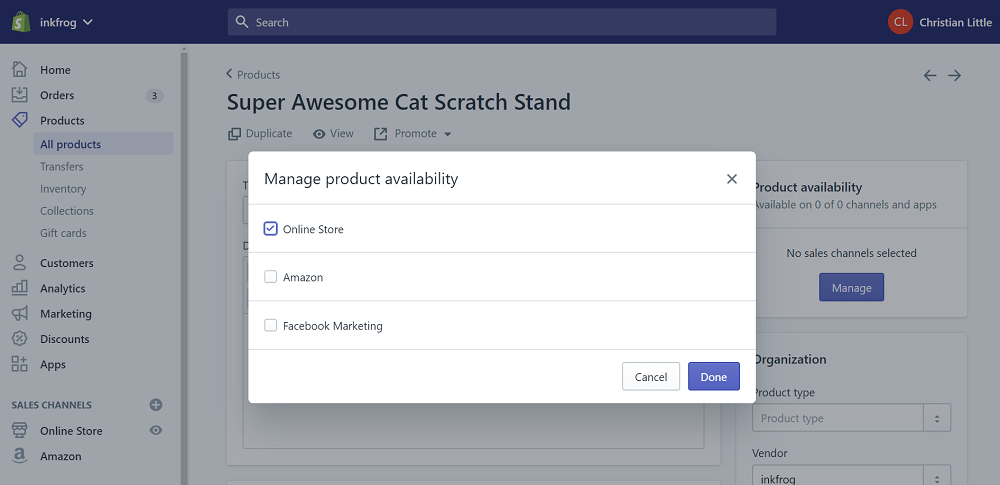
Congratulations! Your product has been exported from eBay to Shopify and is now available for sale on your website. When an order is placed on your Shopify store for the item, we will automatically download the order details and bring them into inkFrog just like we do with everything else!
/lib/images/buy-box-on-Amazon.png
Never underestimate the power of feedback when selling on Amazon. Consumer research reveals that 91% of buyers read product reviews before committing to a purchase. Not only do Amazon reviews tell potential buyers if your product is worth buying but, just as important, they let you know what you’re doing right and, more importantly, what you’re doing wrong. The following guide has been created to help you understand why buyer feedback is so important and, how to make sure that your product reviews are as positive as possible.
Two types of buyer feedback
When selling on Amazon, you are likely to receive two different kinds of feedback and, these are:
Product review
This kind of feedback relates solely to a particular product which you are selling on Amazon. After buying any product on Amazon, the buyer is entitled to leave a review for the product and give it a star rating out of 5 (5 being the highest). The buyer has the option to upload a photograph of the received product and to write a review based on their opinion of the product. Amazon product reviews will largely detail whether or not the buyer was pleased with the item, whether or not it matched the description on the Amazon site and, the overall quality of the item. Product reviews are important as they affect the ranking of the product as well as serving as a buying guide for potential customers.
Seller feedback
This type of feedback is, essentially, all about you! Whereas product reviews concentrate on a particular product and the customer’s satisfaction with that product, seller feedback focuses on how you performed as a seller. After making a purchase from you, the buyer is invited to leave seller feedback to describe their overall purchasing experience.The review may include information about delivery, packaging and customer service.
The buyer will be invited to give a star rating out of 5. The buyer is then asked to answer a series of questions to mark their level of satisfaction on a number of factors including; delivery time, quality of item received and its correlation to the description on Amazon and, customer service. The buyer is also able to leave a short comment
in order to expand on their answers.
Even more important than product reviews, seller feedback aims to inform future buyers as to whether they should not just buy a particular product but, whether they should buy from you at all. Every Amazon seller should be in the habit of reading each and every piece of buyer feedback as this not only affects ranking but can involve penalties if feedback is consistently bad.
How feedback affects you as a seller
Now that we’ve explained the two different kinds of feedback you’re likely to receive from your buyers, it’s time to look at the most important aspect - how this feedback impacts on you as a seller. Buyer feedback is, essentially, a report card for you and your products and affects your seller ranking and your relationship with Amazon as well as serving as a guide for potential new customers. The following are the 10 most important ways in which buyuer feedback will affect you and your business:
Seller Metrics and site relationship
Shopping sites like Amazon and eBay, continuously monitors its sellers and grades them using a number of different metrics. One of the most important metrics is order defect rate (ODR). Your seller ODR looks at your negative feedback - more specifically, the percentage of your sales which received what is deemed to be below standard feedback for whatever reason. A high number of negative feedback which you received will be considered a red flag to Amazon. First, you lose your Buy Box automatically; then you will even lose your seller privilege.
In general, Amazon wants to help sellers to continue to sell their products on their site and so, will usually get in touch if your seller performance falls below their standards. In this case, they will normally give you 60 days to show improvement.
Sellers whose performance continues to be negative may be suspended or blocked from the site.
Seller ranking
This important aspect of Amazon selling shows how well you are doing in relation to sellers offering products in the same categories and subcategories as yours. When you sell a product on Amazon and, when you receive feedback for a sale, this information is used to calculate your ranking. A potential buyer will often check your seller ranking as well as product ranking to ensure that they feel confident in making a purchase from you. The more products that you sell - and the more positive reviews you receive - the higher your ranking which means that your products will be more visible and will attract more buyers.
Product ranking and exposure
As mentioned briefly in the last paragraph, buyer feedback directly affects your product ranking. Each sale and piece of feedback can count toward your product’s overall rating which is measured against other products in similar categories (often identical products.) When a seller performs well and receives consistently positive feedback from customers, they are rewarded by Amazon who will move the seller’s product(s) higher up in their product listings, meaning that you have a much higher chance of your product being viewed by a potential customer (figures show that
customers rarely venture onto page 2 of product listings when browsing).
Conversion rate
One of the most important things for a seller is their conversion rate - i.e. the number of views which lead to purchases. For this, Amazon reviews and seller feedback is vital as, once a customer has clicked onto your product page, the purchase decision will almost certainly be affected by reviews left by previous customers.
Buy Box
The Amazon Buy Box is the white box you sometimes see on the right hand side of a product page (see below). Statistics show that over 80% of Amazon’s sales are made through the Buy Box, which is only available to selected sellers. In order to ‘win’ a Buy Box, you need to maintain consistently great reviews and ranking.
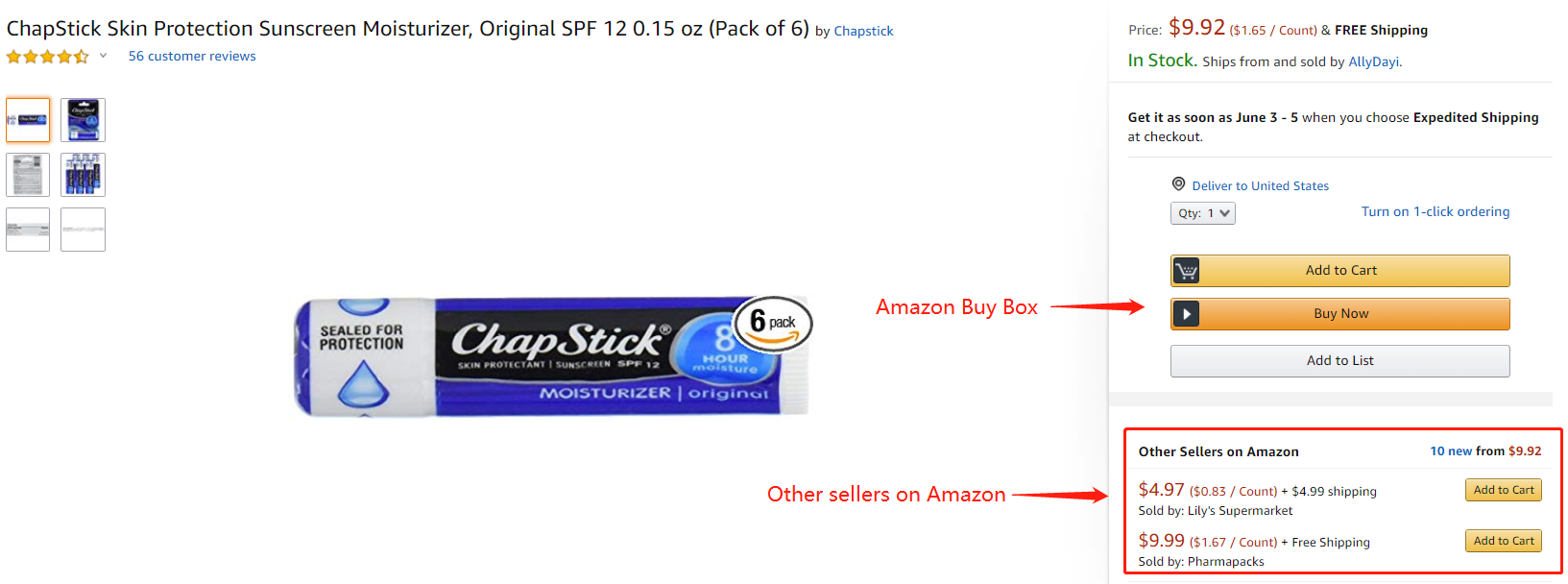
Bad feedback
Although nobody enjoys receiving negative feedback, it’s not all bad news. It’s natural to feel defensive when receiving bad feedback but it can actually help you to provide the best service that you possibly can. Read the feedback carefully and, first, decide if you feel that the comments / rating are fair. If not, contact the customer to ask for further feedback - it could be that they are not using or understanding the product carefully and you may be able to help them - and improve the feedback. If you feel that the comments are fair, it’s time to bring your customer
service skills into play. Contact the customer and offer a replacement or refund and assure them that you take customer satisfaction very seriously.
Understanding the customer
Receiving negative feedback is a great way of finding out what’s not working for you in terms of product and service. By understanding the things that customers don’t like about your product, you can then go on to make improvements. Read the feedback carefully in order to find out the specific reason that the customer was not
satisfied. Check to see if you have more than one review with similar comments - this will help you to understand if this is a case of one ‘difficult’ customer or genuine issue with your product or service.
Product choice
If you receive consistent negative feedback for a particular product, this may give you an indication that, either the product is not good quality or, you are not suited to selling the product. Either way, this feedback enables you to make the choice as to whether or not to keep selling that product. Again, read the feedback carefully to learn the specifics of why customers were not happy with it, such as the product not working properly or the product being perceived as substandard quality. If it’s a faulty product, this is something which you can then take up with your supplier and, if necessary, switch to a more reliable supplier.
Customer care
At the end of the day, your business is all about the customer - and keeping that customer happy. By welcoming customer feedback, you send the message that you actually care about the customer and, their satisfaction with your product(s). Make sure that you respond to all messages and feedback - good or bad. In a digital world, a lack of communication can make buyers feel nervous about spending their hard earned money with a certain business or individual - keeping in touch reassures them that they’re dealing with an actual human being and not just a computer.
Good customer service is always a winner, even in today’s digital world.
Customer loyalty
By listening to your customers and, making improvements when negative feedback is received, you will gain the trust of the customer who, subsequently, will feel confident in buying from you again. This is particularly important if you’re selling a product which has a lot of competition - buyers are fickle and will only stick around if they receive exemplary service and great products. Online or offline, customer loyalty is the foundation of any business.
Brand reputation
As you continue to listen to your customers and to make improvements to your products and services, you are also building your brand’s reputation. A product with great reviews not only encourages customers to buy but, also to recommend the product to friends and family, helping you to grow your client base - and your reputation. You can use social media marketing to great effect by using your positive feedback in your posts and encouraging others to keep sharing your posts.
Conclusion
Of all the things that you concentrate on as an Amazon seller, feedback should be at the very top of your list of priorities. Good feedback instills confidence in a new customer, improves your ranking and exposure and leads to more sales and increased customer loyalty.
Negative feedback and ranking, on the other hand, tends to be an instant red flag for potential customers who will, almost always, scroll away to a more trusted product. As a seller you should always be actively inviting feedback and, on receipt of negative comments, should respond to these immediately in order to build a strong and trusted brand reputation.
To better help you with your buyer feedback, you will need a tool inkFrog to manage buyer feedback on eBay; and if, you are selling on Amazon, a tools just like AMZFinder would do you a great favor!
/lib/images/How-to-Solve-the-Flagged-eBay-Account-2.jpg
Have you ever seen a flagged eBay Account? It happens on the eBay platform, especially for drop shipping retailers. A flagged eBay account will cause views and impressions of its listings to drop, which will slow sales.
Sales slow from time to time, so how can you tell your account has been flagged?
Check your eBay seller account, look at the graphs that show your products views and impressions. A huge decrease in the numbers could mean your account has been flagged. If you are a drop shipper on eBay, know that it takes about a month to crawl your order data to decide if you are drop shipping. eBay drop shippers don’t want to be flagged as there is nothing that can be done with a flagged account.
How can you cope with a flagged eBay seller account? What should you do in this situation?
It’s not the end of the world, but you have to change your business strategy. How can you continue with business in this situation? Let’s break this problem down and give you the best tips for eBay drop shippers. Read on.
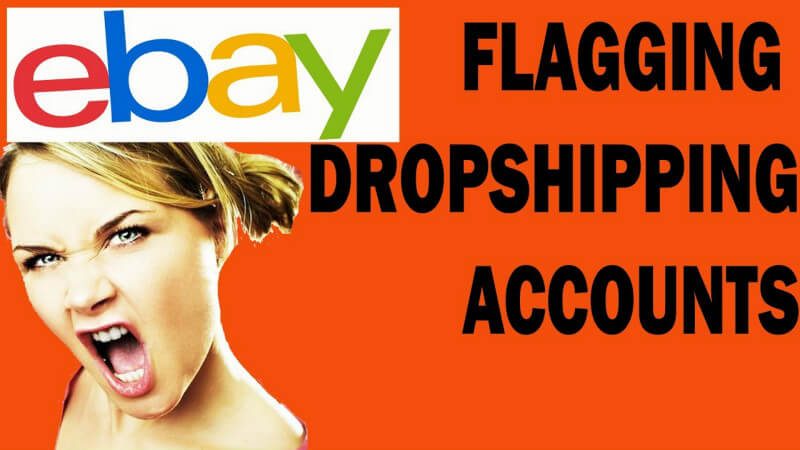
1. Stop drop shipping with the flagged account
If your eBay account is flagged, you need to rethink your current business strategy, change your mindset, and strive for something new. You can call eBay to check the code 587. eBay may tell you the account status and the possible factors that triggered it. It could be because the item location was misrepresented, or pre-sale behavior, or listing manipulation, etc. You can ask if it’s possible that the flag is removed. However, the truth is that eBay will not do this.
eBay have a fixed response: “We can detect when you are in control of your inventory, so there is no need to provide evidence. To comply with the selling practices policy, you must demonstrate a change in your account activity for at least one month. Once compliant, you will see an improvement in search in 1-2 months.”
Any business has setbacks, and you need to be willing to cope with them and learn from them for the future. Never get disheartened or intimidated if something unexpected happens.
Try to learn ideas, methods, and strategies, and figure out the best way to keep a decent profit. Move with the times, innovate, and try new ideas.
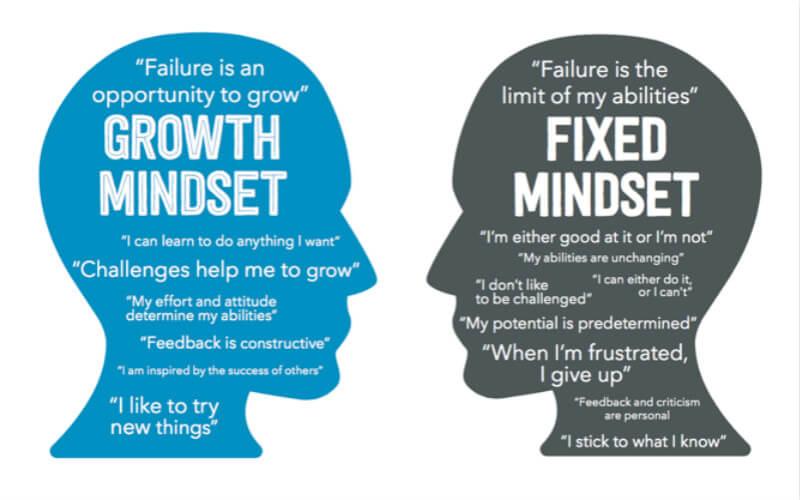
2. Follow the rules
If your account gets flagged, the impressions of your product listings may fall by 70%, leaving a small number of sales. In this situation, you need to figure out ways to move your business forward.
If you still want to continue your drop shipping on eBay, you have to follow the rules regulated by the platform. This means you have to work harder to revise your drop shipping strategy and make everything of your business comply with these regulations. Correct your wrongdoings, and try to keep your business on the right track.
Keep the rules in mind, and then strive to scale your business. Optimize your new eBay store, use with relevant keywords, appealing pictures, and write good product description copy for each listing. Remember to scale it to gain an increasing number of impressions and views.
To maintain a profit and continue successfully trading on eBay, market your new store and products.
To avoid being flagged again, it's better for you to follow the dropshipping policy on eBay.
Learn the lesson, and take actions to reverse the situation.
3. Set the right item locations
eBay has implemented an algorithm to detect and limit the visibility of drop shipping accounts. Once detected, accounts are flagged and restricted.
Several metrics help eBay find a drop shipper that violates the eBay’s drop shipping rules. The algorithm considers return labels, return addresses, and tracking numbers. The most important factor is the product’s location; pay special attention to this. To set the right product location, you could start to use the Amazon FBA program. Amazon FBA will fulfill orders and store your items, which makes it difficult for eBay to detect the product location.
Another idea is to drop ship from China. Most drop shippers selling from China will not be affected by eBay’s algorithm. Further, you can transfer listings with unknown item locations to suppliers that have at least one item location. Amazon third-party sellers meet this description.
When you set your product locations, be consistent, and either make sure your product location is the same as a conventional eBay account or sell from China.
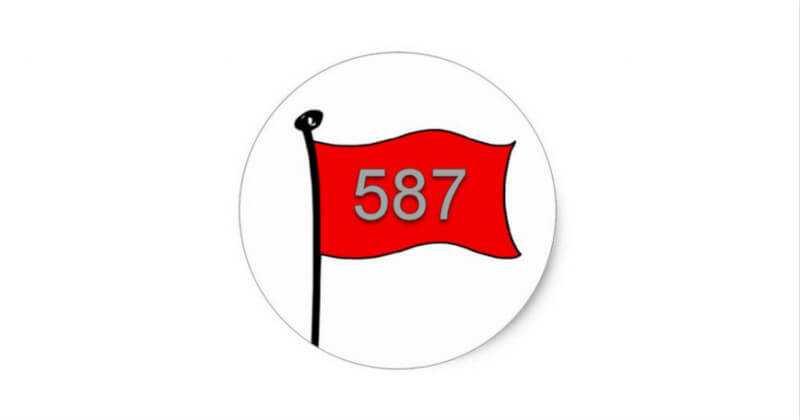
In Conclusion
In a nutshell, it’s no big deal if your eBay account gets flagged. You have options; don’t get frustrated and disheartened. Trust yourself, and believe you will overcome this difficulty by finding new ways to continue. Learn the lesson, follow the rules, and correct your wrongdoings and the product locations. Make sure everything of your business are in line with the drop shipping policy of eBay. Strive hard to adjust your business marketing
strategy. All in all, stay calm and figure out ways to strive for profits. It’s time for you to move forward.
About the Author
Sharline Shaw, the founder of a leelineSourcing.com, is an expert on Chinese export trade. With 10 years experiences in the field of sourcing in China, she is familiar with all relevant regulations and laws about China's exporting. She'd love to share her experience with people and has written many helpful articles.
/lib/images/productlaunch.png
If you own a Shopify store, you already know how difficult it is to keep up with the increasing competition. It isn’t just getting difficult to reach out to more shoppers and acquire customers, but also keep the existing ones engaged with your brand.
Now listing your products on eBay and Amazon with inkFrog helps you reach wider markets and drive more sales for your Shopify store.
You can try social media, email marketing, retargeting and remarketing to keep these customers and subscribers engaged. But that’s exactly what every other Shopify store out there is doing too.
So how do you ensure that the product you’re promoting gets seen amidst the noise?
What are web push notifications?
Web push notifications are messages that a web app or a website can send to their subscribers and customers, whether or not they are on the Shopify store at the time. When it comes to their nature, they are pretty much similar to how mobile apps send push notifications. They delivered straight to the subscriber’s screen - desktop or mobile.
Here’s how they appear on the desktop:
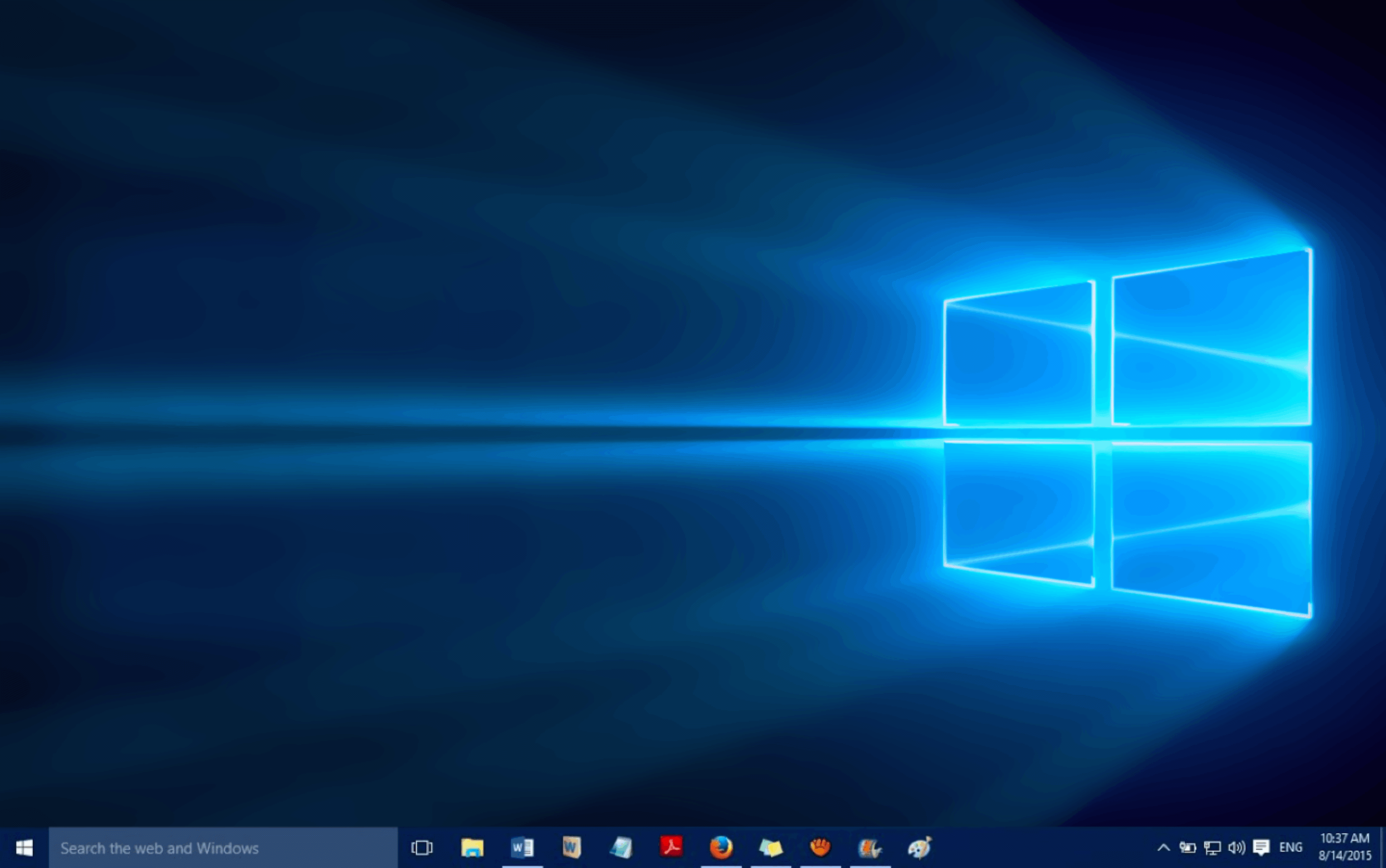
By reaching out to your audience at the right time, with the right message, via the channel that they are already the most active on - web push notifications.
And here’s how they show up on mobile devices:

While their instantaneous nature has been proven to get higher engagement, it is important to strategize your web push notification campaigns well - especially when you’re promoting new products.
So we dug into a few strategies that the top-grossing stores use to bring their new products into the limelight with web push notifications.
Web push notification campaigns to promote new products
1. Product launch
If you’re launching a new product on your Shopify store sometime soon, use web push notifications to build word around it. Keep your customers and subscribers engaged with sneak peeks into what’s coming.
You could release information about one feature at a time until the product finally hits the store!

2. Promotional deal
Once the product hits the store, it is important to ensure that is brought to the shopper’s attention. Now you could wait for them to open the email you sent them or discover the social media post you just made.
But we recommend sending them a quick web push notification. Clubbing your launch message with a special deal or discount is a sure shot way of getting more sales for your new product.

3. Product hacks
The modern shopper wants to be able to make informed purchases. That’s why they take their time doing research when it comes to new products.
Now you can shorten this sales cycle by using web push notifications to share advise, how-tos and hacks about the new product. Make it a point to share content that helps your customers make the most out of the new range.

4. Social media engagement
You’re already making posts about the new product on social media. Instead of just boosting the reach of those posts with paid campaigns, you can also use web push notifications to increase engagement.
Once you start getting engagement on your social media post, you can use the data to set up retargeting campaigns. These campaigns can be used to promote the new product to those who have shown interest in the new product’s post and drive them to make a purchase.

5. Cross-selling
Based on the purchases a customer has made from your store, recommend your new product to them with web push notifications. But remember to remind them quickly of the last purchase they made and how this new product adds more value to the same.
Pretty much similar to how you buy a pair of jeans and the salesperson then recommends you pick a t-shirt from their latest range. Doing this also helps the shopper visualize new products better.
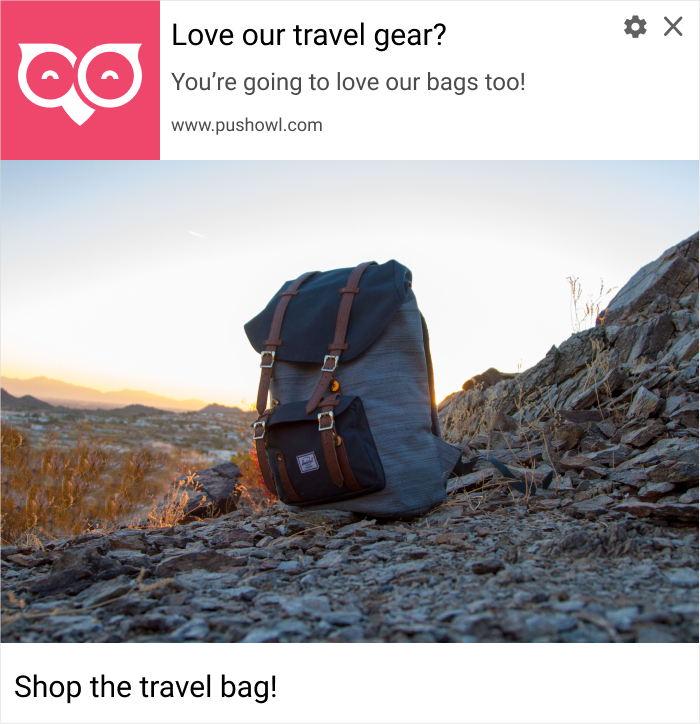
6. Product availability
The above-mentioned campaigns all focus on bringing attention to your new product - its features, its pricing and how it can be used. Now it’s time to also let the shoppers know of your product’s availability!
Use web push notifications to let them know that your products are available on eBay and Amazon as well.

Driving more sales for your new products
Getting started with web push notifications is easy.
With Shopify Apps like PushOwl, it only takes a few minutes to set up a web push notification campaign for your store. With ready-to-use push notification templates for various goals and smart automation, all you need to focus on is crafting an interesting message that a subscriber cannot unsee.
But just as you monitor other marketing channels while promoting your new product, remember to closely monitor how your subscribers and customers interact with web push campaigns. You want to make sure that your message remains relevant at all times and is getting the right amount of engagement you need to drive more sales.
After all, there is no one-size-fits-all approach with web push notifications. You just need to understand what can hype your shoppers about a new product and then leverage the data to craft high-converting campaigns.
Have you used web push notifications for your Shopify store? We’d love to know how you use them to promote new products to subscribers.
Author bio
Vanhishikha Bhargava is a content marketer at PushOwl, an eCommerce web push notification provider for Shopify stores. She can mostly be found digging out growth tactics for online retailers. You can follow her blogs here or talk to her on Twitter.
Posted on June 03, 2019
How Web Push Notifications Can Be Used to Promote Your New Products
Read full article now
/lib/images/katana1.jpg

There will come a time when a business's growth will stagnate. That’s when they should
consider selling on multiple sale channels.
Are you a small manufacturer selling handmade goods? Yes? That’s awesome! But, have you noticed that you’re slowly losing sales? If you don’t diversify your sale channels, you'll eventually lose traction gaining new customers which will slow your business’s growth.
But, don’t panic yet, you shouldn’t rush into this. If you’re selling on one channel and your business is growing, great! Don’t fix what’s not broken. However, the sooner you research the channels you can possibly sell on, and the tools you can use, the sooner you can decide when to scale up.
So, let’s explore the world of multichannel selling and when it’s time to get onboard.
First things first:
What is Multichannel Selling?
Multichannel selling is when a business uses more than one channel to sell their products. Multichannel management could involve selling via a Shopify account while also selling goods through an online marketplace or even offline from a physical location.
So why should you consider selling on multiple channels?
1. Increase Sales
This is the main reason any business would take this approach. It’s essentially a necessity since the habits of shoppers are changing as people drift more toward online shopping. Being on multiple sale channels allows you to increase your exposure since some customers are loyal to certain platforms.
For example, let’s say you’re selling on Shopify and eBay, you’re going to lose potential customers who only purchase items from Amazon.
2. Attract New Customers
If you’re selling on a single channel, be that online or off, it’s going to be difficult to entice new customers and ultimately, it’ll affect your profit margin. For example, if a crafter is only selling products on Etsy, they’re missing out on the customers who search for everything on another platform.
Following a multi-channel strategy in this instance will help you leverage your online presence. So, if someone is searching for a necklace to buy on Amazon, Etsy, or eBay, you’ll be there ready and waiting to sell it to them. Targeting the buyer's journey like this can help reel in new customers.
3. Changes in Technology
As businesses, big and small, have started to use social media channels for promoting their companies, the social media platforms have also adapted to take advantage of this. You can now sell products on Facebook and even Instagram.
This might not seem a big deal, but you need to consider technological advancements, in your market and outside, that's going to affect how you sell to customers in the future. The cool thing is, you can get yourself set up on Instagram and selling products, without having to actually spend any money.
Things You Need to Consider

Caption: Don’t rush into getting set up on every channel you can find. The best approach to selling on multichannel is understanding the best channels for your business and if you're ready to grow in this direction.
It might seem lucrative to get set-up on every sales channel possible. However, doing this could be counter-intuitive and even disastrous to your company.
Firstly, do you have the infrastructure in place to support your business? Inventory management becomes incredibly tricky when having to fulfill sales orders, make deliveries, and update inventory levels for multiple sources.
Good inventory management is essential if you want to keep having good cash flow and happy customers. If you experience a bottleneck because you weren’t coordinating your manufacturing orders effectively or production stops due to stock-outs it’s going to mean customers will have to wait on their products, which will ultimately damage your reputation.
So, what's the trick to handling this? Centralize your business management.
There is software on the market that allows you to organize your business from one place. For example, as a crafter with multiple Shopify stores, you’ll need something to help with the complexity of inventory management. You’ll want software that automatically tracks your Shopify inventory management that’s being shipped from your different Shopify stores.
Bottomline
Selling on multiple channels is, at some point, going to be an approach your business will need to take if it wants to continue making sales and growing.
However, the trick is to research which channels are right for you, have a centralized point to manage your business and the infrastructure in place to support it.
What many other small manufacturers do to overcome these challenges is to implement inventory management software, like the one offered by Katana. It allows them to integrate multiple Shopify stores, receive sale orders, track inventory levels automatically, and manage their production scheduling all from one visual dashboard.
/lib/images/pixc2.png
Listing products on eBay is one of the most important sales strategies for many online retailers across the globe.
But you probably know that already.
After all, eBay is the 11th most popular website in the US and the 41st most popular in the world.
That being said, I won’t tell whether or not you should use eBay, but how you should use it properly.
It all comes down to the quality of your product images and how you optimize your product listings.
With that in mind, today I’ll show you why you need six images to do the trick when it comes to supercharging your eBay image SEO.
How SEO works on eBay (and why you need it)
Optimizing your eBay listings to become relevant for eBay’s search engine algorithm – Cassini, if you’re an SEO nerd– is fundamental if you want your products to reach your customers.
But how do you actually optimize your product listings?
Well, for starters, eBay’s search engine is similar to Google’s.
In both cases, a search query will show up multiple versions of the same product or duplicate content.
Kind of like this:

Unlike Amazon, where each product links to a listing, eBay lists all the products separately, which is why SEO becomes so important if you want to outshine your competitors.
At this point, if you’ve been around for long enough, you’ve probably heard that SEO is all about “keywords”, but that’s not entirely true.
Keywords are important, but they’re just a fraction of SEO.
Cassini, eBay’s search engine, does take keywords into account, but also looks at how relevant a product really is.
To do this, eBay’s search engine asks if this is what the buyer is looking for, if there is enough relevant information and if the product listing educates or entertains the buyer.
For that reason, if your product is displayed near the top of the search results, it’s because your product listing is valuable and accurate to the buyer.
To become relevant for eBay, you need to:
- Optimize the image alt-tags
- Make the buyer experience easy
- Have a record of satisfied customers
- Provide value to potential customers
- Show shoppers that they can trust you
Why meeting eBay’s image requirements is so important
There are 1.2 billion image listings on eBay.
That’s a lot!
Which is why meeting the requirements is critical if you want to rank high and improve your sales conversions.
Also, we believe awesome product photography can make the difference when it comes to selling your products on eBay.
Before a potential buyer even reads your product description or looks at the price, they make snap judgments based on your product images.
Here are a few tips you need to take into account to make sure you’re meeting eBay’s requirements and optimizing your image SEO.
Ebay’s image requirements include that the primary image must show the product and nothing else, that you can add a maximum of 12 images to your listing, and that your images show a real representation of what you’re selling.
On the technical side, make sure you don’t upload images smaller than 500 x 500px or larger than 12MB. Also, stick to the regular image formats like PNG, JPEG, or GIF to avoid issues.
Also, don’t include borders, watermarks, nudity, text, logos, or any other information that you can write in the product description.
If you fail to comply with eBay’s image requirements, you will not only hurt your image SEO but also get your content flagged and penalized.
Why add at least 6 images and not 12?
Although there are many perks to online shopping, nothing compares to being able to physically see and touch the product you’re buying.
For your photos to be able to sell your products, they need to clearly show what you’re selling. Only then, your customer will be confident in what they’re buying.
eBay allows you to upload twelve product images to your product listings, but do you really need twelve images to make your product stand out?
Include enough angles for the customer to see what the product looks like from all sides: front, back, sides, etc. Note that if the sides or front and back of the product are the same, you don’t need to include what looks like the same photo twice.
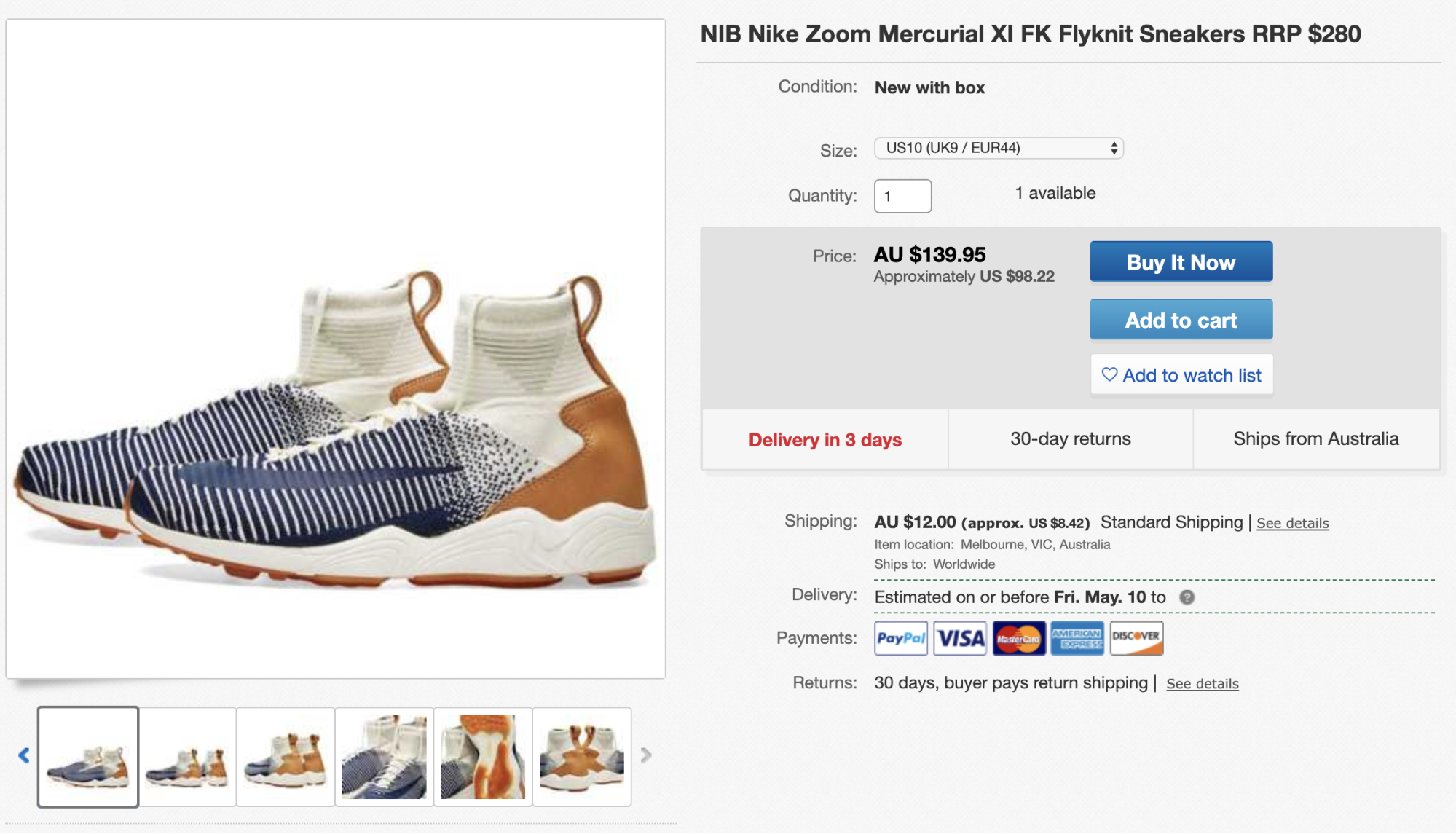
This listing on eBay includes 6 photos of the shoes from different angles including a close up of the sole and details of the material.
Unless your product has a very specific function, chances are your buyers won’t really look at the entire carousel.
That’s why we came to the conclusion that you need at least six photos to optimize your eBay product listings.
Why?
Simple. Let’s say you’re selling a pair of shoes.
You need an image of the front, back, and both sides. That makes four images. You should have one of the shoes (or product) in situ so customers know how it looks and how it could be styled. You also need a close-up image showing the texture and details of the product.
But it’s possible that your customers also want to see a top view of the toe and a picture of the sole.
Remember that more than an object, you’re selling an experience, and since your buyers can’t touch the product, you have to help them feel it.
How to optimize your product images for eBay
Never forget that having high-quality product images is the key to increasing your eCommerce sales.
So, how you use eBay properly?
It all comes down to the quality of your data and how well you optimize it --and your most important piece of data on eBay are your images.
Remove the background and place your product on white
A white background captures the colors of your products better. So, if you’re photographing your products, get a photography sweep to make sure you get your product’s true colors right. If you don’t have a sweep, you can easily build one or hire a service to remove the background of your product photography.
Add relevant alt-tags to your images
If you write your own HTML for listings, be sure you include alt-tags.
These are the keywords that accompany and describe your images to search engines. For that reason, this is another opportunity to optimize your keywords or phrases when they’re relevant to the image.
Luckily for you, inkFrog’s listing tool can help you manage this.
Optimize your product images for the zoom function
Shoppers want to see what the product really looks like. Most shoppers want to zoom in and take a closer look and the fabric and texture of the item.
Your images need to be large enough for them to see the details
Instead of a pixelated blob. Try using images larger than 1000 x 1000px and you’ll be fine.
In conclusion…
Getting your eBay image SEO right takes time and practice, but once you get it right, the results will bring you countless benefits.
Start by optimizing your product descriptions and your images and see what your competitors are doing because you can probably steal a tip or two from them.
When it comes to optimizing your images, just remember that product photography does take a bit of practice and that it’ll take some time to get into a routine of shooting and editing.
Don’t be discouraged if your results aren’t perfect the first time, and make sure you keep a note of what works and what doesn’t.
But, above all, have fun!
Author Bio
Holly Cardew is the Founder of Pixc, a platform to help eCommerce stores edit and optimize their product photos so they can increase sales. Pixc turns average product images into beautiful ones by editing and removing the background within 24 hours.
Starting out as a teenager, selling on eBay and creating her own online marketplace, Holly has a background in eCommerce, online marketing, graphic design and building distributed teams.
When Holly is not working, she loves traveling, exploring new places, great design, eating and coming up with new business ideas.
Posted on May 27, 2019
eBay Image SEO: Why You Need (At Least) 6 Photos to Optimize Your eBay Listings
Read full article now
/lib/images/nozani1.jpg
This article was provided by Noel Lopez, Director of Marketing at Nozani
Many online sellers who aren’t using Amazon yet might ask themselves if selling on that platform is worth it. With a good stream of sales coming in from eBay, Shopify, or other platforms, should you even bother trying to succeed on Amazon?
Simply put, YES! Why? Let’s talk about it!
5 Reasons to Sell on Amazon
1. Amazon is where the majority of people are shopping online
In 2018, 49% of all online retail spend in the United States went to Amazon. That added up to about 5% of all retail sales. To give you a comparison, Amazon’s next competitor, eBay, came in at 6.6% of online retail spend, followed by Apple and then Walmart.
The online bookstore sure has come a long way. Soon, Amazon will receive more online retail spend than all other online competitors combined. And when it comes to users, Amazon has about double the online shoppers as eBay.
These staggering statistics show that more consumers are choosing to spend their money on Amazon than on eBay, Shopify sites, or other online retailers.
2. Third-party sellers are still quite successful
Some sellers might be worried about Amazon taking down third-party sellers as the e-commerce giant sells more of their own products. However, 68% of Amazon’s sales were attributed to third-party sellers, showing that the marketplace is still going strong for third-party sellers.

In fact, new sellers continue to flock to Amazon every day. Each month, over 100,000 new sellers join Amazon to sell their product.
You might also be concerned about Amazon's fees since Shopify or eBay might be cheaper. But Amazon offers a lot more features to sellers which make this cost worth it for many online stores.
3. Amazon makes it easy to package and ship your product
Almost every other online platform requires sellers to be in charge of their own packaging and shipping. However, Amazon offers FBA (fulfilled by Amazon) to sellers. FBA allows sellers to ship their products to Amazon warehouses, where they are shipped out to customers when ordered.
While this service does have a cost, it is often worth it. Sellers can focus on their business and making decisions that matter rather than trying to package and send out orders as they come in.
FBA doesn’t just benefit sellers, but it also benefits customers as well because they know they can trust Amazon to deliver!
4. Customers have high purchase intent on Amazon
Think about why you visited Amazon last time. If you’re like most shoppers, you thought of something you needed (or wanted) and you went to Amazon to look at your options and, ultimately, buy.
Customers who use Amazon have high purchase intent, meaning that they are looking for something specific and are willing and ready to buy. However, not all online shoppers are so ready to buy.
If you have a Shopify site, for example, people might come across your store through Google or Instagram. Their intent is to browse, to see what kinds of products you sell, and to check out your prices. These shoppers are still gathering information; they haven’t necessarily decided to buy yet.

5. Amazon offers an awesome ad platform
If you’re selling on eBay, then you might have some promoted listings, but they’re not even close to Amazon ads. Shopify sellers can choose to run advertisements through Google Ads, but there isn’t a native platform to create ads to promote your store.
Amazon, however, offers a thorough and extensive ad platform that can get your listings in front of the right people. You can create very specific audience targeting so your money is spent most effectively. Plus, the platform gives you a lot of data, which provides insights for tweaking and optimizing your ad campaigns.
At the end of the day, you should always include Amazon in your online selling strategy. This platform is a great complement to the platforms you are already using. As the company continues to grow, we will see more and more of the market share going to this e-commerce powerhouse, so don’t miss out on the potential sales!
For more information on how Amazon can benefit your business, reach out to our experts!

Posted on April 15, 2019
Should You Sell on Amazon If You’re Already on eBay or Shopify?
Read full article now
